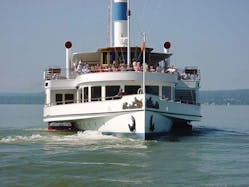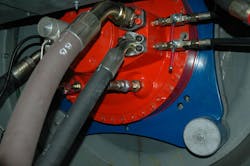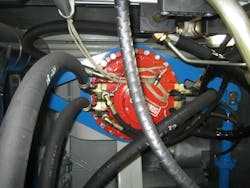On Lake Ammersee, near Munich, Germany, two paddle steamers take passengers through the Alpine foothills. A popular vacation activity, travelers experience the natural beauty of Bavaria while using modern Swedish-German technology. The two steamers, RMS Diessen built in 1908, and RMS Herrsching built 70 years later, use intriguing drive technology. Diesel engines are used to supply a hydraulic system that drives the paddles directly from two heavy-duty engines from Bosch Rexroth. This technology allows the hydraulic motors to provide full torque across the entire output range, so the boats need no mechanical transmission units, and they react quickly to control orders.
The paddle steamers have two 500-cc variable-displacement pumps. The pumps run at a maximum speed of 1,500 rpm, and a maximum theoretical flow of approximately 7,35 1iters/min. The normal working pressure is between 150 to 200 bar and maximum working pressure is 330 bar.
The maximum torque varies for the two ships. With two motors sized 240 Nm/bar, boat Herrsching’s normal working torque is approximately 32 to 44 kNm/motor, and maximum torque is roughly 75 kNm. For boat Diessen, two motors at 210 Nm/bar, normal working torque is around 28 to 38 kNm/motor, and maximum torque is approximately 67 kNm.
For boat Herrsching the motor’s max speed is approximately 47 rpm, but the mainly used speed is 35 rpm. Boat Diessen’s maximum motor speed is around 55 rpm, and normal speed is 38 rpm. Motor speed is controlled through pump flow by changing the swash angle. An encoder mounted on the motor monitors the speed. The boat’s speed is approximately 20 km/h.
The drives on each boat are independently driven. Each hydraulic motor having its own pump ensures equal flow.
For more from Bosch Rexroth visit www.boschrexroth.com




